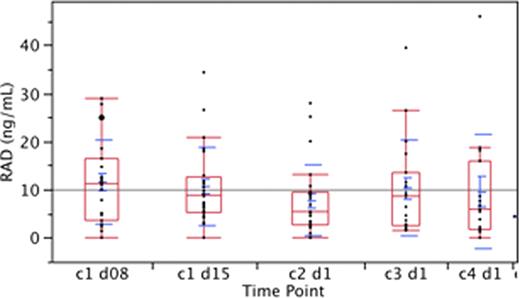Abstract
Abstract 2802
Redundancy of pro-survival signaling pathways promotes survival and drug resistance in lymphoid and plasma cell malignancies. In particular, the PI3K-Akt and the MEK-ERK pathways have been shown to play an important role in the proliferation and survival of these malignant cells induced by various cytokines in the tumor microenvironment. Sorafenib, a Raf kinase and VEGF receptor inhibitor, and everolimus, an mTOR inhibitor, have synergistic cytotoxicity in myeloma and lymphoma cells due to inhibition of multiple signaling pathways.
We designed a Phase 1/2 clinical trial to identify the maximum tolerated doses of the two drugs used in combination and the efficacy of the combination. Patients (Pts) with relapsed myeloma or lymphoma were eligible for enrollment. Pts were required to have an absolute neutrophil count ≥1500 × 10(6)/L, a platelet count ≥75,000, and a serum creatinine 21.5 mg/dL. The study utilized the classic 3+3 design. Extensive pharmacokinetic studies were performed to better delineate potential drug interactions.
Twenty-six pts were accrued from August 2007 to February 2009. Four pts discontinued sorafenib during cycle 1 for various reasons (2 patient refusal, 1 unrelated medical condition and 1 physician discretion) and were excluded from MTD determination. An additional pt did not have measurable disease and was ineligible, leaving 19 pts with lymphoma (including 6 with Hodgkin lymphoma) and 2 with myeloma for phase I analysis. The pts had a median age of 56 years (range, 22, 69) and were heavily pretreated with a median of 4 prior therapies (range, 1–10). Eighteen (86%) had received a prior stem cell transplant. Four dose limiting toxicities were seen across all dose levels (Table). These included grade 3 vomiting (level 1), grade 4 thrombocytopenia (level 2 and 3, one each) and grade 2 hand and foot rash leading to treatment delay (level 3). Overall, 13 pts experienced a grade 3 or 4 hematologic toxicity. Grade 3 or 4 anemia, neutropenia, and thrombocytopenia occurred in 19%, 43%, and 38% of pts, respectively. Four pts have experienced a grade 3 non-hematologic toxicity; no grade 4 non-hematologic toxicities were seen. Grade 3 non-hematologic toxicities included hypokalemia, weight loss, vomiting, hand-foot skin reaction, fatigue, and elevated alkaline phosphatase. Dose level 1 (sorafenib 200 mg and everolimus 5 mg daily) was best tolerated and was selected for phase 2 evaluation.
The ORR was 33% (7/21;95% CI: 15–57%, Table) with 3 pts at dose level 0 (2 PR, 1 CR), one at level 2 (1 PR) and three at level 3 (2 PR, 1 CR) responding. The responders included 5 pts with Hodgkin's disease and one each with an NK cell and T-cell lymphoma. Pts have received a median of 6 cycles (range: 1–19) of treatment. 16 pts have discontinued treatment due to disease progression (13 pts), non-resolution of cytopenias (1 pt), physician discretion (1 pt), and death on study due to lymphoma (1 pt). Disease progression has been seen in 16 pts; 9 pts have died. Median follow-up for pts still alive is 18.7 months (range: 11.5–29.4). 6 pts died from disease progression, one each due to sepsis unlikely related to treatment, cholecystitis, and unknown causes.
Sorafenib is metabolized by the cytochrome P450 CYP3A enzyme and RAD-001 mainly by the CYP3A4 system in the liver, hence there is a potential for interactions. The detailed PK analyses performed as part of this trial showed a decrease in the RAD001 levels following initiation of sorafenib on day 8 of cycle 1 (Figure).
The combination of sorafenib and everolimus is safe at a recommended phase 2 dose of sorafenib 200 mg and everolimus 5 mg daily. There is no significant drug interaction seen. Activity has been observed, especially in the setting of Hodgkins Disease.
| Dose Level . | Sorafenib (mg/dose) . | RAD001 (mg/dose) . | Number of DLTs . | Number of Responders . |
|---|---|---|---|---|
| 0 | 200 twice daily | 5 every other day | 1/6 | 2 PR, 1 CR |
| 1 | 200 twice daily | 5 every day | 0/5 | No responders |
| 2 | 400 twice daily | 5 every day | 1/5 | 1 PR |
| 3 | 400 twice daily | 10 every day | 2/5 | 2 PR, 1 CR |
| Dose Level . | Sorafenib (mg/dose) . | RAD001 (mg/dose) . | Number of DLTs . | Number of Responders . |
|---|---|---|---|---|
| 0 | 200 twice daily | 5 every other day | 1/6 | 2 PR, 1 CR |
| 1 | 200 twice daily | 5 every day | 0/5 | No responders |
| 2 | 400 twice daily | 5 every day | 1/5 | 1 PR |
| 3 | 400 twice daily | 10 every day | 2/5 | 2 PR, 1 CR |
Kumar:Celgene: Consultancy, Research Funding; Millennium: Research Funding; Merck: Consultancy, Research Funding; Novartis: Research Funding; Genzyme: Consultancy, Research Funding; Cephalon: Research Funding. Off Label Use: Lenalidomide for treatment of newly diagnosed myeloma. Witzig:Novartis and Celgene: Patents & Royalties, Research Funding, Served on advisory boards with Novartis and Celgene – both uncompensated with compensation to Mayo Clinic.
Author notes
Asterisk with author names denotes non-ASH members.



This feature is available to Subscribers Only
Sign In or Create an Account Close Modal